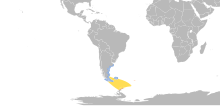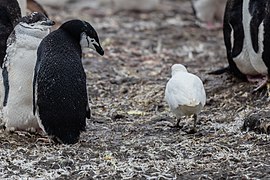Snowy sheathbill
| Snowy sheathbill | |
|---|---|

| |
| Scientific classification | |
| Domain: | Eukaryota |
| Kingdom: | Animalia |
| Phylum: | Chordata |
| Class: | Aves |
| Order: | Charadriiformes |
| Family: | Chionidae |
| Genus: | Chionis |
| Species: | C. albus
|
| Binomial name | |
| Chionis albus (Gmelin, JF, 1789)
| |

| |
| Synonyms | |
Vaginalis alba Gmelin, 1789 | |
The snowy sheathbill (Chionis albus), also known as the greater sheathbill, pale-faced sheathbill, and paddy, is one of two species of sheathbill. It is usually found on the ground. It is the only land bird native to the Antarctic continent.[3]
Taxonomy
The snowy sheathbill was formally described in 1789 by the German naturalist Johann Friedrich Gmelin in his revised and expanded edition of Carl Linnaeus's Systema Naturae. He placed it in a new genus Vaginalis and coined the binomial name Vaginalis alba.[4] Gmelin based his description on the "white sheath-bill" that had been described and illustrated in 1785 by the English ornithologist John Latham
in his A General Synopsis of Birds .
Description
A snowy sheathbill is about 380–410 mm (15–16 in) long, with a wingspan of 760–800 mm (30–31 in). It is pure white except for its pink, warty face; its Latin name translates to "snow white".[11]
Sheathbills spend 86% of their day hunting for food and the other 14% resting.[12]
Distribution and habitat
The snowy sheathbill lives in
Feeding
The snowy sheathbill does not have webbed feet. It finds its food on land. It is an
Sheathbills that are actively hunting for food spend approximately 38% of the day hunting, 20% of the time eating their prey, 23% just resting, 14% doing various comfortable activities, and the final 3% will be towards agonistic behavior.[12]
Gallery
-
Flying sheathbill
-
This snowy sheathbill is watched carefully by a chinstrap penguin, as they are predators of penguin chicks and eggs
-
Eating regurgitated penguin chick food
-
Snowy sheathbill walks by an Antarctic fur seal, at Cooper Bay, South Georgia
-
Adult snowy sheathbill, on Barrientos Island
References
- . Retrieved 12 November 2021.
- ^ The Internet Bird Collection. "Pale-faced Sheathbill (Chionis alba)".
- ^ ISBN 1-4054-3679-4.
- ^ Gmelin, Johann Friedrich (1789). Systema naturae per regna tria naturae : secundum classes, ordines, genera, species, cum characteribus, differentiis, synonymis, locis (in Latin). Vol. 1, Part 2 (13th ed.). Lipsiae [Leipzig]: Georg. Emanuel. Beer. p. 705.
- ^ Latham, John (1785). A General Synopsis of Birds. Vol. 3, Part 1. London: Printed for Leigh and Sotheby. pp. 268–269, Plate 89.
- ^ Peters, James Lee, ed. (1934). Check-List of Birds of the World. Vol. 2. Cambridge, Massachusetts: Harvard University Press. p. 308.
- ^ Brabourne, W.; Chubb, C. (1912). The Birds of South America. London: R.H. Porter. p. 36.
- ^ Forster, Johann Reinhold (1788). Enchiridion historiae naturali inserviens, quo termini et delineationes ad avium, piscium, insectorum et plantarum adumbrationes intelligendas et concinnandas, secundum methodum systematis Linnaeani continentur (in Latin). Halae: Prostat apud Hemmerde et Schwetschke. p. 37.
- ^ Rasmussen, Pamela, eds. (August 2022). "Buttonquail, thick-knees, sheathbills, plovers, oystercatchers, stilts, painted-snipes, jacanas, Plains-wanderer, seedsnipes". IOC World Bird List Version 12.2. International Ornithologists' Union. Retrieved 17 October 2022.
- ISBN 978-1-4081-2501-4.
- ^ ISBN 1-894004-59-0.
- ^ JSTOR 4514110.






